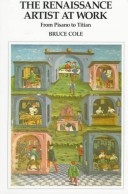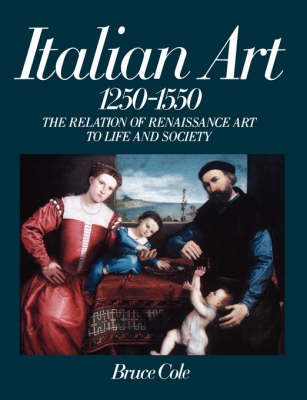Icon Editions
2 total works
This book gives the necessary background for the study and appreciation of Italian painting and sculpture from about 1250 to 1550. It tells how the artists learned their craft, the organization of their workshops, and the guilds they belonged to; how their customers or patrons treated them and where their work was displayed?churches, civic buildings, or private homes. The book discusses how art was made?tempera, oil, panel, canvas, fresco; it surveys the characteristic types of Renaissance art?altarpieces, portraits, tombs, busts, doors fountains, medals, etc.
This survey of Italian Renaissance art, from a new and different perspective, shows how art was a vital part of society and how all types of art and artists reflected the needs and aspirations of the culture from which they arose. Most books on Renaissance art are based on a chronological study of the major artists and their works. In this book, Bruce Cole covers the major types of art from c. 1250 to c. 1550, discusses their origins and development, documents their use and function, and describes their form and how and why the artists shaped them that way. Art is thus firmly connected with the life and society of the Renaissance rather than viewed as a separate entity: painting and sculpture are seen in their proper context. This survey of Italian Renaissance art, from a new and different perspective, shows how art was a vital part of society and how all types of art and artists reflected the needs and aspirations of the culture from which they arose. Most books on Renaissance art are based on a chronological study of the major artists and their works. In this book, Bruce Cole covers the major types of art from c. 1250 to c.
1550, discusses their origins and development, documents their use and function, and describes their form and how and why the artists shaped them that way. Art is thus firmly connected with the life and society of the Renaissance rather than viewed as a separate entity: painting and sculpture are seen in their proper context. After a wide-ranging introduction, there are chapters on Italian Renaissance art in relation to domestic life, worship, civic life, death and afterlife, and Renaissance images and ideals.
1550, discusses their origins and development, documents their use and function, and describes their form and how and why the artists shaped them that way. Art is thus firmly connected with the life and society of the Renaissance rather than viewed as a separate entity: painting and sculpture are seen in their proper context. After a wide-ranging introduction, there are chapters on Italian Renaissance art in relation to domestic life, worship, civic life, death and afterlife, and Renaissance images and ideals.

